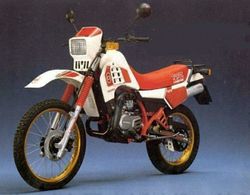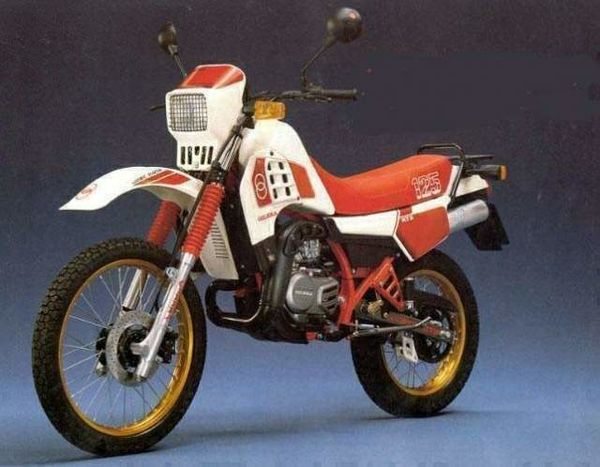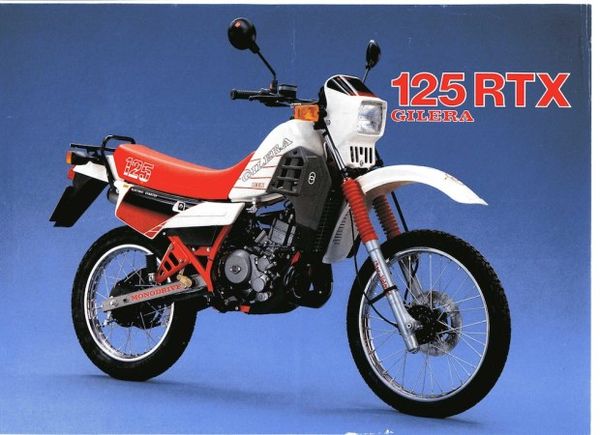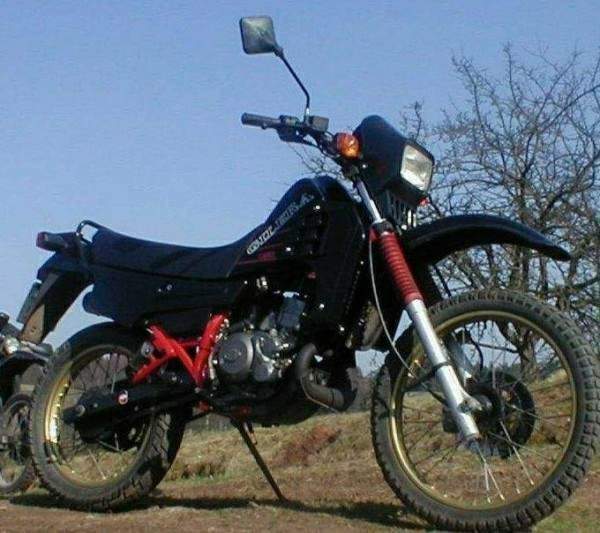Difference between revisions of "Gilera RTX125"
(template fixes) |
|||
| Line 55: | Line 55: | ||
[[File:Gilera-RTX125-85--1.jpg|600px|Gilera RTX125]] | [[File:Gilera-RTX125-85--1.jpg|600px|Gilera RTX125]] | ||
== | == Review == | ||
On the other hand, a glorious brand like Gilera, today almost abandoned kept alive for a kind of therapeutic hardship, in the past and especially between the eighties and nineties was a thriving producer of 125, sports and enduro, which made a whole generation dream. The forerunner of the 1980s road enduros was undoubtedly the RX 125. At the same time as the RV125 road, the Casa di Arcore presented its enduro cousin, named RX125, at the 1983 Milan Motor Show. In common, the two bikes had the engine, slightly revised in the RX, which therefore had one horse less, a practice widespread at the time by all the motorcycle manufacturers, who used the same thermal group for road and enduro models, usually intervening on the power or on the beams. | |||
The bike had the classic road enduro line of the time, so with mask and high fenders. The frame was a closed double cradle tubular with boxed plate reinforcements, floor that he always shared with the RV. | |||
The engine was, of course, the 124.3cc two-stroke single-cylinder, with a 56 and 50.5 mm run and a run, respectively, with a laminated and counter-shaft, powered by a 26 mm Dell'Orto PHBH carburetor, which is identical to that of the RV. The different exhaust system and some slight changes to the thermal group resulted in a slightly different delivery and a maximum power of 19 hp at 7,750 rpm, compared to the 20 hp at 8,000 rpm of the RV. | |||
The gearbox was 6-speed and pedal-starting, but with 150,000 lire more it was possible to have the electric one. The bike had a 35 mm Marzocchi fork with 200 m of excursion, while the rear fork adopted a shock with 185 mm of excursion. The wheels had professional enduro sizes, with the 1.65x21 front with 2.75 tire and the 2.15x18 rear with 4.10 tire. The brakes were mixed, with a 230mm front disc and a 140mm rear drum. | |||
The tank eventually had a capacity of 13 liters. The instrumentation was quite complete, as in the two circular instruments it provided speedometer, counters, gasoline indicator and temperature plus four spies for crazy arrows, oil and dazzling. The RX 125 reached a stated top speed of 115 km/h, in line with the competition. | |||
Speaking of competition, in fact, at the time it was not | |||
there were still many rivals of this bike. In practice, the only one to give | |||
thread to twist to the enduro of Arcore was the Cagiva Aletta Red, which paid | |||
however, a slightly lower power of the project is slightly lower (little | |||
more than 15 hp), although it had from its an even cheaper price of | |||
2,550,000 land and in those years sold about 1000 units per month. | |||
Once again, as with VR, Paolo Martin took care of the design. During the | |||
realization of the project was also thought of a Dakariana version with | |||
increased tank, which at the time was quite a lot even among 16-year-olds. | |||
Immediately after the presentation of the RX, then came the Arizona RX, which | |||
22-litre tank, with an eagle on a star-like background | |||
and stripes in homage to the state of Arizona, but also for some accessories | |||
Africans such as the bellows to the fork, the disco cover, the parasassi grill | |||
on the front headlight, the handrails and the back tool bag. | |||
The colors available at launch were for both the RX and | |||
for the Arizona RX the white with red friezes and black saddle (later on the | |||
Arizona the saddle turned red) or red with black saddle and later | |||
black with red saddle. As with the RV, the RX was also presented with the | |||
200 version with 183.4cc engine, achieved by increasing the laose to 68 mm. | |||
From the always valid site gilerarv200.it we find that, at | |||
in March 1984 the House of Arcore immaculately registered 385 RX, | |||
roughly half of the Red Wing, which were 725 in that month but 3,675 | |||
from the beginning of the year, since it entered the market before. At the end of | |||
that year, the Gilera RX and RX Arizona reached 6,475, more or less always | |||
the half of Cagiva, which touched 13,652, but Arcore's house surpassed that | |||
total registration numbers. The challenge was open! | |||
In 1986, or rather at the end of 1985, there was an evolution | |||
rather important of the enduro brianzole. In fact, they were presented, in | |||
replacement of the RX and Arizona, the RTX 125 and the Arizona Hawk RX, both | |||
with more powerful engine and 70% redesigned components. The two bikes | |||
even though the public's preferences tended more towards | |||
lArizona Hawk, who had a stronger story and above all an appearance and a | |||
evocative names of great rallies. | |||
These at least seem to be the least rational and | |||
more emotional than they did prefer the RX to the RTX. In the meantime, at the Rally of | |||
Sardinia in 1985, the House of Arcore presented itself with a motorcycle called the RX 250 | |||
Arizona Rally, which was really nothing but the prototype of the future RC | |||
Rally 250, sister of 125. | |||
Returning to the Road RX and RTX, both models were | |||
black or white livery, coupled with the red saddle. In practice, new | |||
were all the plastics, just as the instrumentation was redesigned and it was | |||
added a paramotor plate. | |||
Also renewed is the chassis, the Paioli fork, the 240 mm disc brake, the | |||
gold anodized circles (optional) and much more. While the tank | |||
of the RTX remained 13 litres like that of the RX, that of the Arizona Hawk | |||
became a little smaller than the Arizona tank: it went down in fact | |||
22 to 17 litres. | |||
On a mechanical level, the Power Jet system is not | |||
BPF (By Pass Feed) which extended the feeding | |||
compression phase, as well as a new electronic ignition control unit | |||
Capacitor Discharge Ignition (CDI) and a different CDI (Capacitor Discharge Ignition) | |||
Exhaust. The declared power increased to 22 hp, delivered to 8,800 laps (25 hp to 7,500 | |||
200), while the top speed was 125 km/h. | |||
It also went up the price, taking it to over 3,500,000 lire, | |||
while the electric starter increased its price by 100,000 lire in just two | |||
Years. The RX paved the way for the subsequent enduro of Casa Gilera, which from there | |||
little gradually increased the list of models on the list. | |||
==Specifications== | |||
{| class="wikitable" | {| class="wikitable" | ||
|- | |- | ||
| Line 259: | Line 207: | ||
|} | |} | ||
== External Links == | == External Links == | ||
* https://translate.google.com/?hl=en#auto/en/Unaltra Gilera 125 è la protagonista di Amarcord di questa settimana, la RX 125. Condivideva con la RV 125 motore e telaio e fu una enduro rivol | * https://translate.google.com/?hl=en#auto/en/Unaltra Gilera 125 è la protagonista di Amarcord di questa settimana, la RX 125. Condivideva con la RV 125 motore e telaio e fu una enduro rivol | ||
Revision as of 21:19, 30 November 2019
 |
|
| Gilera RTX125 | |
| Manufacturer | |
|---|---|
| Production | 1986 |
| Engine | Two stroke, single cylinder, reed valves induction |
| Compression ratio | 13.4:1 |
| Ignition | CDI |
| Transmission | 6 Speed |
| Suspension | Front: Telescopic forks Rear: Swing arm gas single shock |
| Brakes | Front: Single 220 mm disc Rear: 140 mm Drum |
| Front Tire | 2.75-21 |
| Rear Tire | 4.10-18 |
| Weight | 121 kg / 266.7 lbs (dry), 137 kg / 302 lbs (wet) |
| Fuel Capacity | 15 Liters / 3.9 US gal |
| Manuals | Service Manual |
Engine
The engine was a Liquid cooled, cooled Two stroke, single cylinder, reed valves induction. The engine featured a 13.4:1 compression ratio.
Chassis
It came with a 2.75-21 front tire and a 4.10-18 rear tire. Stopping was achieved via Single 220 mm disc in the front and a 140 mm Drum in the rear. The front suspension was a Telescopic forks while the rear was equipped with a Swing arm gas single shock. The RTX125 was fitted with a 15 Liters / 3.9 US gal fuel tank. The bike weighed just 121 kg / 266.7 lbs.
Photos
Review
On the other hand, a glorious brand like Gilera, today almost abandoned kept alive for a kind of therapeutic hardship, in the past and especially between the eighties and nineties was a thriving producer of 125, sports and enduro, which made a whole generation dream. The forerunner of the 1980s road enduros was undoubtedly the RX 125. At the same time as the RV125 road, the Casa di Arcore presented its enduro cousin, named RX125, at the 1983 Milan Motor Show. In common, the two bikes had the engine, slightly revised in the RX, which therefore had one horse less, a practice widespread at the time by all the motorcycle manufacturers, who used the same thermal group for road and enduro models, usually intervening on the power or on the beams.
The bike had the classic road enduro line of the time, so with mask and high fenders. The frame was a closed double cradle tubular with boxed plate reinforcements, floor that he always shared with the RV.
The engine was, of course, the 124.3cc two-stroke single-cylinder, with a 56 and 50.5 mm run and a run, respectively, with a laminated and counter-shaft, powered by a 26 mm Dell'Orto PHBH carburetor, which is identical to that of the RV. The different exhaust system and some slight changes to the thermal group resulted in a slightly different delivery and a maximum power of 19 hp at 7,750 rpm, compared to the 20 hp at 8,000 rpm of the RV.
The gearbox was 6-speed and pedal-starting, but with 150,000 lire more it was possible to have the electric one. The bike had a 35 mm Marzocchi fork with 200 m of excursion, while the rear fork adopted a shock with 185 mm of excursion. The wheels had professional enduro sizes, with the 1.65x21 front with 2.75 tire and the 2.15x18 rear with 4.10 tire. The brakes were mixed, with a 230mm front disc and a 140mm rear drum.
The tank eventually had a capacity of 13 liters. The instrumentation was quite complete, as in the two circular instruments it provided speedometer, counters, gasoline indicator and temperature plus four spies for crazy arrows, oil and dazzling. The RX 125 reached a stated top speed of 115 km/h, in line with the competition.
Speaking of competition, in fact, at the time it was not there were still many rivals of this bike. In practice, the only one to give thread to twist to the enduro of Arcore was the Cagiva Aletta Red, which paid however, a slightly lower power of the project is slightly lower (little more than 15 hp), although it had from its an even cheaper price of 2,550,000 land and in those years sold about 1000 units per month.
Once again, as with VR, Paolo Martin took care of the design. During the realization of the project was also thought of a Dakariana version with increased tank, which at the time was quite a lot even among 16-year-olds. Immediately after the presentation of the RX, then came the Arizona RX, which 22-litre tank, with an eagle on a star-like background and stripes in homage to the state of Arizona, but also for some accessories Africans such as the bellows to the fork, the disco cover, the parasassi grill on the front headlight, the handrails and the back tool bag.
The colors available at launch were for both the RX and for the Arizona RX the white with red friezes and black saddle (later on the Arizona the saddle turned red) or red with black saddle and later black with red saddle. As with the RV, the RX was also presented with the 200 version with 183.4cc engine, achieved by increasing the laose to 68 mm.
From the always valid site gilerarv200.it we find that, at in March 1984 the House of Arcore immaculately registered 385 RX, roughly half of the Red Wing, which were 725 in that month but 3,675 from the beginning of the year, since it entered the market before. At the end of that year, the Gilera RX and RX Arizona reached 6,475, more or less always the half of Cagiva, which touched 13,652, but Arcore's house surpassed that total registration numbers. The challenge was open!
In 1986, or rather at the end of 1985, there was an evolution rather important of the enduro brianzole. In fact, they were presented, in replacement of the RX and Arizona, the RTX 125 and the Arizona Hawk RX, both with more powerful engine and 70% redesigned components. The two bikes even though the public's preferences tended more towards lArizona Hawk, who had a stronger story and above all an appearance and a evocative names of great rallies.
These at least seem to be the least rational and more emotional than they did prefer the RX to the RTX. In the meantime, at the Rally of Sardinia in 1985, the House of Arcore presented itself with a motorcycle called the RX 250 Arizona Rally, which was really nothing but the prototype of the future RC Rally 250, sister of 125.
Returning to the Road RX and RTX, both models were black or white livery, coupled with the red saddle. In practice, new were all the plastics, just as the instrumentation was redesigned and it was added a paramotor plate.
Also renewed is the chassis, the Paioli fork, the 240 mm disc brake, the gold anodized circles (optional) and much more. While the tank of the RTX remained 13 litres like that of the RX, that of the Arizona Hawk became a little smaller than the Arizona tank: it went down in fact 22 to 17 litres.
On a mechanical level, the Power Jet system is not BPF (By Pass Feed) which extended the feeding compression phase, as well as a new electronic ignition control unit Capacitor Discharge Ignition (CDI) and a different CDI (Capacitor Discharge Ignition) Exhaust. The declared power increased to 22 hp, delivered to 8,800 laps (25 hp to 7,500 200), while the top speed was 125 km/h.
It also went up the price, taking it to over 3,500,000 lire, while the electric starter increased its price by 100,000 lire in just two Years. The RX paved the way for the subsequent enduro of Casa Gilera, which from there little gradually increased the list of models on the list.
Specifications
| Make Model | Gilera RTX 125 |
|---|---|
| Year | 1986 |
| Engine Type | Two stroke, single cylinder, reed valves induction |
| Displacement | 124 cc / 7.6 cu-in |
| Bore X Stroke | 56 x 50 mm |
| Cooling System | Liquid cooled, |
| Compression | 13.4:1 |
| Induction | 2x 26mm Dell'Orto carburetor |
| Ignition | CDI |
| Starting | kick |
| Max Power | 24 hp /18 kW @ 9250 rpm |
| Max Torque | 1.5 kgf-m @ 10500 rpm |
| Transmission | 6 Speed |
| Final Drive | Chain |
| Front Suspension | Telescopic forks |
| Rear Suspension | Swing arm gas single shock |
| Front Brakes | Single 220 mm disc |
| Rear Brakes | 140 mm Drum |
| Front Tire | 2.75-21 |
| Rear Tire | 4.10-18 |
| Dry Weight | 121 kg / 266.7 lbs |
| Wet Weight | 137 kg / 302 lbs |
| Fuel Capacity | 15 Liters / 3.9 US gal |
External Links
- https://translate.google.com/?hl=en#auto/en/Unaltra Gilera 125 è la protagonista di Amarcord di questa settimana, la RX 125. Condivideva con la RV 125 motore e telaio e fu una enduro rivol
- http://www.motoblog.it


